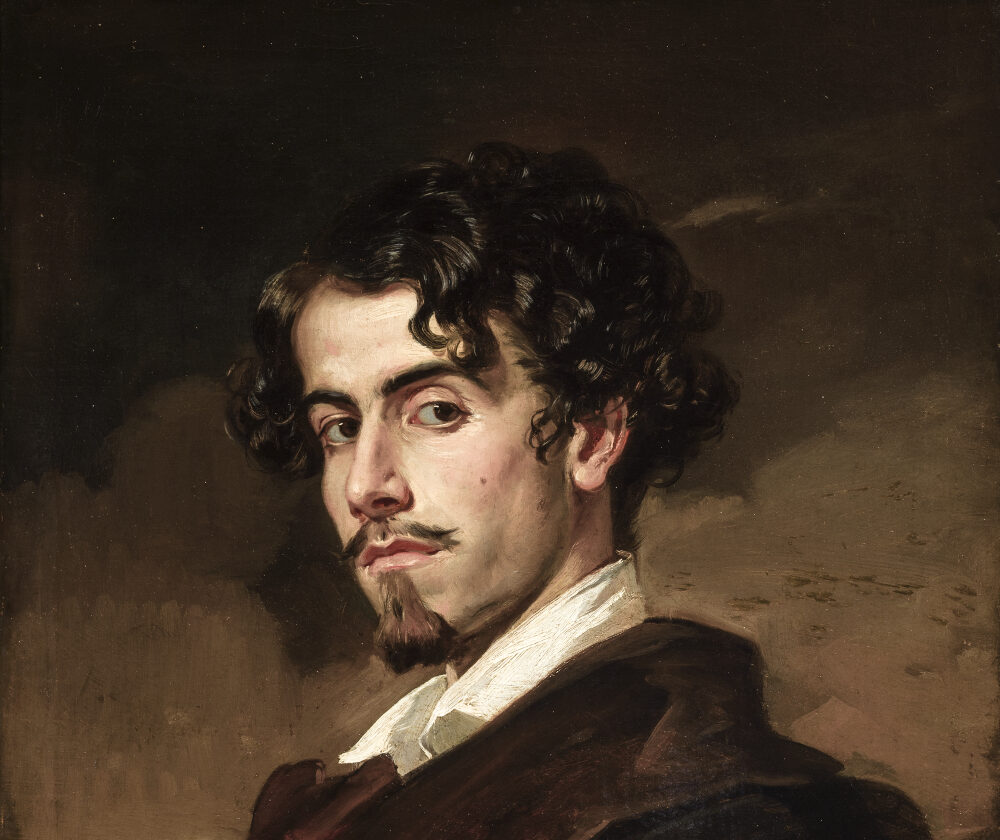“Puede no haber poetas, pero siempre / habrá poesía.”(“There may not be poets, but there will always be poetry.”)
G.A. Bécquer
Gustavo Adolfo Bécquer (Gustavo Adolfo Domínguez Bastida, Seville Feb. 17, 1836-Dec. 22, 1870) is the highest representative of post-Romantic poetry, with an intimist tendency. His distinguishing feature is the apparent simplicity of expression that moves away from the rhetoric of Romanticism. His work markedly influences poets such as Rubén Darío, Antonio Machado, Juan Ramón Jiménez, and the poets of the generation of 27.
Critics have always considered Bécquer, a forerunner of contemporary poetry. But the poet and writer is, above all, a “living poet,” the life of his Rhymes is nourished by popular poetry in the broadest sense of the word, but his verses, even with simple expressions, are expressions of supreme beauty. A beauty that does not die, which continues to be an object of interest for numerous readers.
Gustavo Adolfo Bécquer is a poet prodigy; the son and brother of painters, he was orphaned at the age of ten and lived his childhood and adolescence in Seville. He began writing poetry early and with marvelous perfection; at age eleven, he wrote “Ode to the Death of Don Alberto Lista”; a year later, the Seville Literary Review published “The Gift of Andalusia,” characterized by great metrical precision achieved by a sure hand in the light musicality of the rhymes.
In the spring of 1858, Bécquer, debilitated by a serious undiagnosed illness, bedridden for two months, worried his many friends who rushed to his bedside. Shortly thereafter, one of them, rummaging through papers, finds the text “The caudillo (leader) of the hands,” which obtains publication. The poet, however, succeeds, fortunately manages to recover. In the year 1860, Gustavus B. is diagnosed with syphilis, by which time the disease has already caused severe damage to his right eye, causing him to squint severely.
Bécquer goes into a coma on the night of December 21, but before he loses consciousness, he gives his best friend, Augusto Ferrán, some papers to burn in addition to his rhymes for publication, telling him, “I have a premonition that I will be better known dead than alive.” After an entire night of agony, he died at ten o’clock in the morning of December 22, 1870.
A poet was buried, but came back to life with his poetry.
(self-quotation)
After the poet’s death, his friends Ferrán and Narciso Campillo gathered on December 29 of that same year to read, for the first time, Bécquer’s rhymes. His volumes saw the light of day in 1871; all subsequent editions of “Rime” bear this first edition. Bécquer’s friends subdivided the poems thematically; the current numbering, corresponds to this first subdivision. This thematic arrangement is accepted by critics.
The works
On December 17, 1859, his first rhyme (number XIII) appeared in the magazine “El nene,” with the title “Imitation to Byron. “Actually, the second passage of the future rhyme XIII is a paraphrase of the first passage of the poem “Hebrew Melodies,” by Lord Byron. The blue gaze appears in these verses by Bécquer; the poet’s imagination at this time is dominated by cerulean eyes.
“¿Qué es poesía?, dices mientras clavas en mi pupila tu pupila azul. ¿Qué es poesía? ¿Y tú me lo preguntas?… Poesía eres tú…”
“What is poetry? You say as you nail in my pupil your blue pupil. What is poetry? And you ask?…Poetry is you…”
Gustavo Adolfo Bécquer published sixteen poems in his lifetime, circulated in newspapers of the time, many of them, published anonymously or signed simply with “B.” None of these rhymes are among those that today are declared: “fundamental,” not even the most famous: that of the loneliness of the dead and that of the swallows. Bécquer is best known as the author of the “Leyendes”; some of his work published in Madrid is also published in other journals in Spain. Future Rhymes are appreciated in the “after,” as he presaged, in eternity.
His immense fame is based on the “Rhymes” to characterize the Spanish Post -Romantic current; with marked propensity for intimism, inspired by the work of the German Heine, heir in some ways, of Goethe. The rhymes are in opposition to rhetoric.
In the context of the Spanish Romantic movement, his work is highly innovative.
The “Rhymes” amount to a total of eighty-six compositions. The content of the “Rime” is divided into four groups: the first (From Rhymes I to Rhymes XI) contains some reflections on poetry and literary creation; the second group (From Rhymes XII to XXIX) , focuses on love and its effects on the poet’s soul; in the third group (From Rhymes XXX to Rhymes LI) disillusionment, lack of love, and disappointment predominate; The fourth group (From Rhymes LII to Rhymes LXXXVI) shows the poet about to face death and the idea of death with great doubts about the existence of love, predominated by a distrust of the world. The rhymes are preceded by an introduction that serves as a prologue for his entire work.
Her poetics is imbued with sensitivity, her Rhymes represent a songbook of love, in and around a female creature in the innermost fibers of love passion, like a magnetic attraction, a vital woman with a magical gaze. Her poetics is characterized by a realism of ideals, far from utilitarian and social realism. Bécquer’s Rhymes are sewn into his skin, between an “I” and a “Thou.” with contiguous and opposing phrases of consent and dissent. The rhymes constitute a “leyenda” of her human adventure; within these rhymes one can encounter three protagonists: “The Present Woman,” “The Absent Woman in Her Trace,” and “The Petrified Woman,” So it is possible to grasp “the empirical I” in relation to three aspects of woman. These three groups are characterized by a “metalinguistic ego” that unifies the various sections. In this reservoir of emotions, the distinction between “the poet-man” and “the transcendent poet” appears crucial. The strong correlation between the poet-man and the poet-transcendent as well as the inherent ambiguity between the two cloak the work in a mystery that is difficult to decipher.
In the rhymes depicting the woman present, bodily elements and natural elements are highlighted.
Body elements:
H.IX. I embrace you. I penetrate into your soul. XIII. Eyes, blue pupils, there radiates an idea. XVI.
Sunny eyes, and their image, into the unknown.
Elements of nature:
In these rhymes, mulieval body parts attract and assimilate to parts of nature.
XX. Lips of her burned by inflamed air, soul kissing gaze.
No one like Bécquer was able to write “the hymn of the aura” with words that were at the same time sighs and laughter, colors and notes”; the poet was able to emphasize the musicality of the word to represent a musical-pictorial-theatrical panorama that multiplies the implicit value of his rhymes.
In the woman-track section of lost love, pride and dignity alternate; here the words: “endurance” , “will” –
XXXI. Passion depicted as a farce; she was left weeping and laughing; he only wept. LVI. Only at departure is there life for him. XLVI. He, dignified, though dead of love, while she thinks him calm after slaughtering him. XLVIII. Voluntarily suppressed the image of her, but the vision of her remains tenacious. LVIII. Love of an instant; only thus is its memory preserved.
In the petrified woman section, the upheaval of real and symbolic nature is captured in the presence of the overwhelming, unsettling woman as she passes by. XL. There is no mask like her face. Oblivion. S.III. Chaste, flower of his desert. LXVII. Beautiful the spectacle of nature, sleeping and eating; but what a pity that this is not enough.
In the Rhymes we catch metaphors bordering on the metaphysical with a tendency toward Romanticism, Enlightenment and sometimes even positivism; the whole is interpenetrated with naturalistic, sensory and spiritual elements giving his poetics a colorful magnetism.
Poem Amor Eterno
Podrá nublarse el sol eternamente;
podrá secarse en un instante el mar;
Podrá romperse el eje de la tierra
como un débil cristal.
¡Todo sucederá! Podrá la muerte
cubrirme con su fúnebre crespón;
pero jamás en mí podrá apagarse
la llama de tu amor
Poem of eternal love
It may cloud the sun eternally;
Will be able to dry up the sea in an instant;
Will be able to break the axis of the earth
Like a weak crystal.
Everything will happen! Will death be able
Cover me with its funereal ripple;
However, it can never be extinguished in me
The flame of your love.
VIII
Cuando miro el azul horizonte
perderse a lo lejos,
al través de una gasa de polvo
dorado and restless,
me parece posible arrancarme
del mísero suelo
y flotar con la niebla dorada
en átomos leves
¡Cual ella deshecho!
Cuando miro de noche en el fondo
dark of the sky
las estrellas temblar como ardientes
pupilas de fuego,
me parece posible a dó brillan
subir en un vuelo
y anegarme en su luz, y con ellas
en lumbre encendido
fundirme en un beso.
En el mar de la duda en que bogo
ni aun sé lo que creo;
sin embargo, estas ansias me dicen
que yo llevo algo
divino aquí dentro.
Translation by Yuleisy Cruz Lezcano
VIII
When I look at the blue horizon
Getting lost far away,
To within a veil the dust
Golden and restless,
it seems possible for me to uproot myself
from the miserable land
And float with the golden mist
in mild atoms
Like that undone.
When in the night I look into the depths
dark of the sky
The stars tremble, as burning
Pupils of fire,
It seems possible to me there where they shine
soar
And shipwreck in their light, and with them
in kindled splendor
Melt into a kiss.
In the sea of doubt in which I navigate
I still don’t know what to believe in
And yet, these anxieties tell me.
That I bear something
Of divine in here!…
XXXIII
Es cuestión de palabras, y no obstante,
ni tú ni yo jamás,
después de lo pasado, convendremos
en quién la culpa está.
¡Lástima que el Amor un diccionario
no tenga donde hallar
cuándo el orgullo es simplemente orgullo
y cuándo es dignidad!
XXXIV
Tacit passes and are his motions
silent harmony;
The footsteps sound and the sound reminds me
Of the winged hymn the rhythmic measure.
He goes squinting, those eyes of his.
Clear yes as the day,
And burns all that exists on earth and in heaven
Of new light in his pupils.
He laughs, and his fresh laughter resembles
To a runaway water;
cries, and each tear is a poem
Of infinite sweetness.
Dwell in her the light, in her the aroma,
color and line,
The form, generating the desires,
expression, arise of poetry.
Maybe she is stupid?… But! As long as she keeps silent
Keep the enigma obscure,
That which is silent will always apply to me
More than what any other tells me.
In addition to the rhymes, Bécquer composed 28 “Leyendas” in which some typical elements of Romanticism are observed, such as impossible love, loneliness, misery, mystery, the exotic, the ordinary and the supernatural. The natural landscape is emphasized in these legends, but it has value in relation to the soul.
Recognizing this great poet and writer as a master, I urge everyone to read and delve into his work!
Before his death from tuberculosis Becker writes:
When my pale remains
Already they press the earth,
On the forgotten pit
Who will come crying?
Who, in short, the next day,
When the sun shines again,
I have passed through this world,
Who will remember it?
The article Gustavo Adolfo Bècquer, a manual for healing the soul comes from TheNewyorker.

